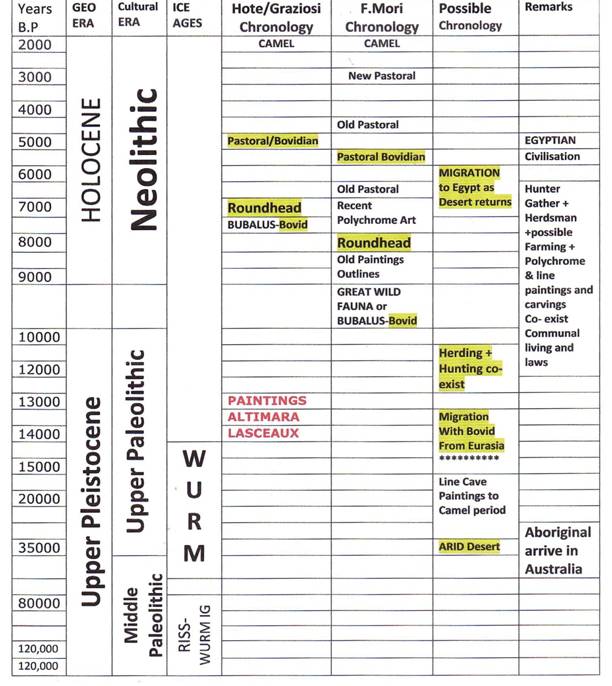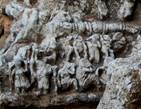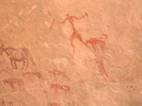
Harrow and Hillingdon Geological Society
Climate Change & African Art
Home | Monthly Meetings | Field Trips | Exhibitions | Other Activities | Members Pages | Useful Links
Did climatic changes in Europe give rise to the rock carvings in North Africa?
Bob Maurer
The conventional wisdom is that very modern Palaeolithic man came out of Africa into Europe. Certainly, it is believed that Homo heidelbergensis, the common ancestor of both modern humans and Neanderthals evolved into modern humans in Africa and into Neanderthals in cooler Europe. Early modern humans first arrived in Europe between 40,000 and 35,000 years ago and co-existed with Neanderthals for several thousand years before the Neanderthals died out about 30,000 years ago. Most of the studies of early modern humans has been based on the development of stone-tool industries – Achulian, Musterian, Aterian etc.
Bob questioned this wisdom by speculating that very modern upper Palaeolithic man migrated south with his herds of cattle via Italy and Sicily into Libya to escape the cold weather in Europe in order to survive. He suggested that this was the first chronologued migration due to climate change and that modern man’s cognitive abilities may have matured in Eurasia. This would have occurred at the peak of the last ice age (20-18,000 years ago), when sea levels were about 100m lower than today, reducing the gaps between Italy, Sicily and Libya.
Evidence in support of this thesis is the 9,000-year old carvings outside Benghazi of Hippopotamus, humans wearing clothes and a long-horned bovine similar to those painted in the caves of Lascaux and Altemira. In the south of Libya, paintings on the wall of a cave show stick-men, very similar to the Bushman art of southern Africa.
|
|
|
|
Humans wearing clothes |
Long-horned bovine |
Battle scene |
Clothed herdsmen |
The latter shows short-legged humans (bushmen) in a battle with long-legged raiders. Bushman art is generally stylised and there is occasional hand painting. Polychrome drawings of eland are found in Natal. Bushman art now shows evidence of the Great Trek. One of the major problems is how do you date the rock art.
Returning to Libya, Bob showed pictures of stick-men hunting deer with dogs and paintings of camels, which are not native to Africa but were introduced in biblical times. There were also battle scenes between apparently naked stick-men (African) and invaders wearing clothes. The latter are also shown herding long-horned cattle. Other art shows hippos, rhinos, elephants, lions, crocodiles, deer and domestic cows with a hump. Further developments include humans with animal heads slaughtering a rhinoceros and there are patent comparisons to be made with similar anthropomorphic figures in ancient Egyptian art.
A number of chronologies have been proposed for the development of rock art in Africa from the end of the Ogolian Desert 12,000 years ago, through early Neolithic settlements in the Sahara, early pastoral African fauna (Bubalus), later pastoral, 4,000 years ago, the horse period and the camel period.
Bob compared the chronologies proposed by Hote and Graziosi and by F. Mori and proposed a possible new chronology based on the cognitive trail through the rock art development. He concluded that the typical evidence shows that modern man with a highly developed cognitive ability migrated south via Italy and Sicily from ice-age Europe with his cattle in the late Palaeolithic. Re-desertification of the Sahara region about 6,000 years ago would have resulted in migration north and north-east towards the Nile basin, which formed part of the fertile crescent. He suggested this may have been the start of the Egyptian civilisation based on the similarities of the art.

Bob finally concluded that a rt rather than stone tool shapes may yield a better insight into human development and migration patterns in Paleolithic/Neolithic times.



